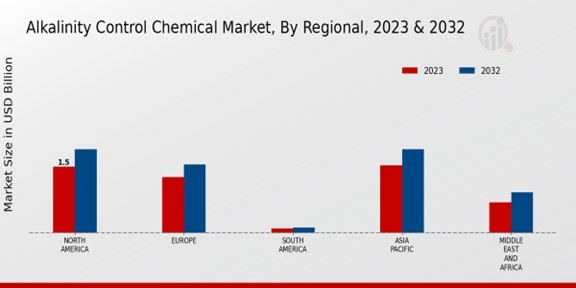Rising Industrial Applications
The Global Alkalinity Control Chemical Market Industry is witnessing a rise in industrial applications, particularly in sectors such as mining, pulp and paper, and chemical manufacturing. These industries require precise pH control to optimize their processes and ensure product quality. The increasing complexity of industrial operations necessitates the use of alkalinity control chemicals to mitigate risks associated with pH fluctuations. As industries expand and evolve, the demand for these chemicals is expected to grow, contributing to the overall market expansion. This trend underscores the versatility and essential nature of alkalinity control chemicals across various industrial sectors.
Expansion of the Agricultural Sector
The Global Alkalinity Control Chemical Market Industry benefits from the expansion of the agricultural sector, where alkalinity control chemicals are utilized to enhance soil quality and crop yield. Farmers increasingly recognize the importance of maintaining appropriate soil pH levels to optimize nutrient availability. This trend is particularly pronounced in developing countries, where agricultural productivity is critical for economic growth. As a result, the market is expected to witness a steady growth rate, contributing to a projected value of 6.91 USD Billion by 2035. The integration of these chemicals into modern farming practices suggests a promising future for the industry.
Increasing Demand for Water Treatment Solutions
The Global Alkalinity Control Chemical Market Industry experiences a notable surge in demand driven by the increasing need for effective water treatment solutions. As industries and municipalities strive to meet stringent water quality regulations, alkalinity control chemicals play a crucial role in maintaining optimal pH levels in water systems. This trend is particularly evident in regions with high industrial activity, where the market is projected to reach 5.35 USD Billion in 2024. The growing awareness of water scarcity and the necessity for sustainable practices further bolster the demand for these chemicals, indicating a robust growth trajectory for the industry.
Regulatory Support for Environmental Protection
Regulatory support for environmental protection plays a pivotal role in shaping the Global Alkalinity Control Chemical Market Industry. Governments worldwide are implementing stringent regulations aimed at reducing pollution and promoting sustainable practices. This regulatory landscape encourages industries to adopt alkalinity control chemicals as part of their compliance strategies. For example, initiatives aimed at improving water quality in industrial discharges necessitate the use of these chemicals to neutralize acidic effluents. Consequently, the market is poised for growth as businesses seek to align with environmental standards, thereby enhancing the demand for alkalinity control solutions.
Technological Advancements in Chemical Production
Technological advancements in the production of alkalinity control chemicals significantly influence the Global Alkalinity Control Chemical Market Industry. Innovations in manufacturing processes lead to more efficient production methods, reducing costs and enhancing product quality. For instance, the adoption of green chemistry principles allows for the development of more environmentally friendly alkalinity control agents. These advancements not only cater to the growing demand for sustainable solutions but also improve the overall competitiveness of the market. As the industry adapts to these changes, it is likely to experience a compound annual growth rate of 2.36% from 2025 to 2035.




















Leave a Comment